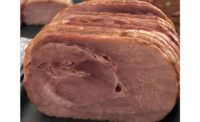Cleaning up marinades
Natural labels are chemical-free but still require multifunctional ingredients.




Clean labels are certainly here to stay, but what replaces the chemicals being erased from marinades?
“Everyone is waiting for the miracle molecule that will replace phosphate,” says Terry Houser, Ph.D., associate professor at Kansas State University, in Manhattan, Kan. “But I’m not aware of one so far. Phosphate is a unique application and hard to replace.”
Traditional marinades for pork and chicken, at least, contain salt, water, sodium phosphates and sodium lactate. Injected brines, marinades and phosphates are used to improve meat flavor, texture and shelf life. They are added through injector needles, brine or marinade mixing tanks, filters, a heat exchanger and saddle tank.
While this process has existed in some form for probably 80 years or longer, its chemicals don’t mesh with the natural and clean label movement. So, poultry and pork processors have been pulling phosphates out of their process, and lactates will likely be next.
“Why? Because they aren’t label friendly,” Houser says.
Phosphates have been around for decades in marinades because they establish muscle-to-muscle binding, stabilize meat batter emulsions, increase yield and protect color and flavor from oxidation. So their replacements need to offer similar benefits, but naturally.
“We see folks using more vinegar, for example, in product to control spoilage,” Houser says.
Nature’s other antimicrobials are rosemary and green tea, which is used in fresh sausage now, Houser says.
“Natural ingredients exert the functionality of marinades and antimicrobials to improve quality,” says Anand Mohan, Ph.D., extension coordinator and associate professor at the University of Georgia, based in Athens, Ga. “They improve quality and antimicrobial functionality but are natural in the sense that the ingredients or marinades are from natural sources.”
Generally, natural ingredients for marinades are sourced through the fermentation process or are from fruits or vegetables such as celery powder or citrus fiber as a binder.
Plum ingredients, such as fresh plum concentrate and dried plum powder and puree, are another powerful binder. They also improve yield, shelf life and flavor, and provide natural coloring for many applications.
Poultry products have commonly used modified cornstarch in their tumbling process. But according to sampling tests by Texas A&M University, rice starch produced similar yields to modified cornstarch.
“The challenge is that these ingredients are not as well known or may have only low levels of functionality with proteins and flavor,” Mohan says.
Some natural marinades struggle with increased purge and quality issues, while others do not, he says.
“Vinegar powder, for example, is a good antimicrobial but causes darkening of meat, which is a quality issue because of discoloration,” says Mohan. “The industry needs to be aware that natural ingredients are good but don’t offer all functionality in one ingredient.”
The industry is looking for natural multifunctional ingredients to improve taste, flavor and mouth feel of the product, Mohan says.
“But all products are not equal,” he says. “Pork, beef and chicken need to be treated differently.” Acidic marinades, for example, do well when injected in poultry, but cause tremendous quality issues in beef, Mohan says. “Quality should be the top priority.”
Moreover, when ingredients such as phosphates are removed, there are unintended consequences.
“I think when companies go the clean-label route, they need to carefully look at the ingredients being used, ask why they are there and be prepared for the consequences of removing them,” Houser says. “I don’t think phosphates are completely dead but will be more limited in their applications.”
Reducing sodium
Salt also plays an important role in marinades. It maximizes water holding, adds flavor and improves antimicrobial features, Houser says.
But “companies are also trying to reduce sodium,” he says.
Less salt, however, can result in increased purge and quality issues with spoilage and shelf life.
Uncured meat products have successfully substituted sodium nitrite, sugar, phosphates, salt and brine with a celery mixture that has natural-occurring nitrites, sea salt and other flavors including beet and parsley extracts.
Do they provide a road map for marinades that include less sodium? It’s too early to tell.
“There’s a tremendous amount of natural cured products on the market, called uncured,” says Houser. “Natural cured meat products are no longer a niche, but have fairly significant market share — over 50 percent.”
Oscar Mayer and Ballpark Franks are all pushing uncured meat, which uses celery powder as a natural ingredient. “Nothing tells me that consumers are going to be less concerned with labels because major companies are marketing their natural ingredients,” Houser says.
Preventing cross-contamination
Many companies use spray injection with their marinades to better disperse flavor through muscles, but it isn’t without disadvantages.
“Marinades are sprayed at high speeds, so they get deeper into the product,” Mohan says. “But they don’t prevent brine or marinade pockets. A pocket could cause quality problems like very salty, high sodium areas in the product because the marinade is trapped in one place.”
Technology is always improving with needles that distribute ingredients, as well, notes Houser.
It’s needed to prevent cross-contamination, which can come from the knives, equipment, conveyor belt and employees, Mohan says.
“Processors are aware of environmental monitoring programs that address basic GMP (good manufacturing practices) to address quality and safety,” says Mohan.
If processors are using spray injection, they need to be careful of aerosolizing marinades, because if this splatter is not cleaned it can form a biofilm for micro-organisms to grow, he says. Biofilms attach to a surface and form a protective home for bacteria, fungi and algae that they are loathe to give up. Biofilm pathogens, moreover, are 1,000 times more resistant to traditional sanitizers.
“Then, pathogens get into the product through cross-contamination,” says Mohan.
Effective biofilm removal technology is critical because marinade equipment that is covered in nutrients are so inviting to pathogens. The equipment at risk — needles, tubing, clean-in-place piping, heat exchangers and saddle tanks — are also not well suited to disassembly and hand scrubbing, so prevention is critical.
The Food and Drug Administration’s Food Safety Modernization Act requires companies to redesign or address sanitation processes, Mohan says.
“An older facility and equipment has more potential for negative conditions like pathogen growth and moisture to build up,” says Mohan. “Equipment must be addressed through a major preventative program. A lot of smaller and medium-sized companies have more to do designing and upgrading new facilities and programs.” NP
Looking for a reprint of this article?
From high-res PDFs to custom plaques, order your copy today!












